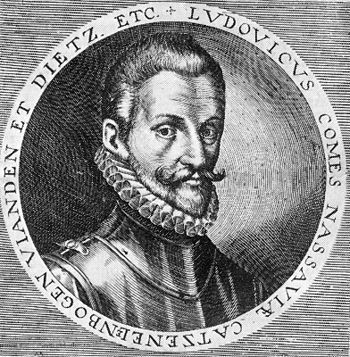Louis of Nassau
Count Louis of Nassau (Dillenburg, January 10, 1538 – Mook, April 14, 1574) was a younger brother of William the Silent, the leader of the Dutch revolt against King Philip II of Spain. Louis served as a secretary and consultant to his brother and, as Lutheran Calvinist, assisted him in the struggle against the Roman Catholic Spaniards.
Biography
Louis was the sixth child of William the Rich and the fourth of his mother Juliana of Stolberg-Wernigerode, who was his father's second wife. He studied in Strasbourg and went to war against France from 1557 to 1559 in an army led by his brother William and the count of Egmont. From then on he acted as a traveling ambassador for his brother, making relations with German noblemen such as Maurice of Saxony and other Electors. He underheld the contacts of his brother with the leaders of the French Huguenots, the prince de Condé (Louis of Bourbon) and Gaspard de Coligny. He played a pivotal role in the drawing up of the marriage contract between his brother William and Anna of Saxony, the daughter of Maurice.
After the start of the Dutch revolt in 1568 Louis stayed primarily in France, where he was in contact with Swiss Calvinists who supported financially the armies that invaded the The Netherlands in aid of the Dutch revolt (1568, 1572 and 1574). Under the influence of these followers of John Calvin, Louis, who was born Lutheran, became (Lutheran) Calvinist. In cooperation with Philips of Marnix, lord of Saint-Aldegonde who was converted from Lutheran to Calvinist, he converted the whole Nassau family to the Calvinist doctrine, after long theological discussions at Dillenburg Castle.
Dutch revolt
On the eve of the revolt Louis was one of the instigators of the Compromis des Nobles, an open letter to King Philips II of Spain petitioning him to stop the Inquisition in The Netherlands. On April 5, 1566 the "Compromise" was presented to the regent Margaretha of Parma. During this audience, count Charles of Berlaymont, chairman of her financial council, tried to ease her mind with the words ce ne sont que des gueux (they are just beggars). From then on the revolutionaries carried the name Geuzen (Les Gueux) as a name of honor. In reaction to the petition, king Philips II sent troops to quell the unrest, with as commander the forceful Duke of Alba.
In 1568 Louis hired a mercenary army and invaded The Netherlands in the north of the country. This is generally seen as the start of the eighty year war. He defeated a small Spanish army in the Battle of Heiligerlee (May 23), but withdrew into Germany when the Duke of Alba came north with a large army. Louis was beaten on July 20, in the Battle of Jemmingen (now Jemgun in Germany). One of the Nassau brothers (Adolf) fell in the battle of Heiligerlee.
After the Watergeuzen had had some success (they took the city of Brielle in 1572), Louis invaded the southern part of the Low Countries and captured Bergen (in French: Mons) in Henegouwen (in French: Hainaut) on May 23, 1572. The Duke of Alba laid siege to Bergen (Mons) and since in the meantime Gaspard de Coligny, who had promised to come to the rescue, was killed (his murder started the St. Bartholomew's Day Massacre of 24 August – 3 October 1572), Louis had to surrender the city to the Duke of Alba on September 19. The Duke let Louis go.
Louis made yet another effort to come to the aid of the revolution and hired a new mercenary army that invaded The Netherlands in Limburg, near the city of Maastricht. The Spanish, who had just started a siege of the city of Leiden, broke up the siege and met Louis's army, that had among its ranks the youngest Nassau brother, Henry of Nassau, on the Mook heath. This resulted in the Battle of the Mookerheyde of April 1574 in which both Nassau brothers lost their lives. Their bodies were never recovered.
Reference
Article on Lodewijk van Nassau in Grote Winkler Prins, Encyclopedie in twintig delen, 7th edition, Elsevier, Amsterdam (1972).
